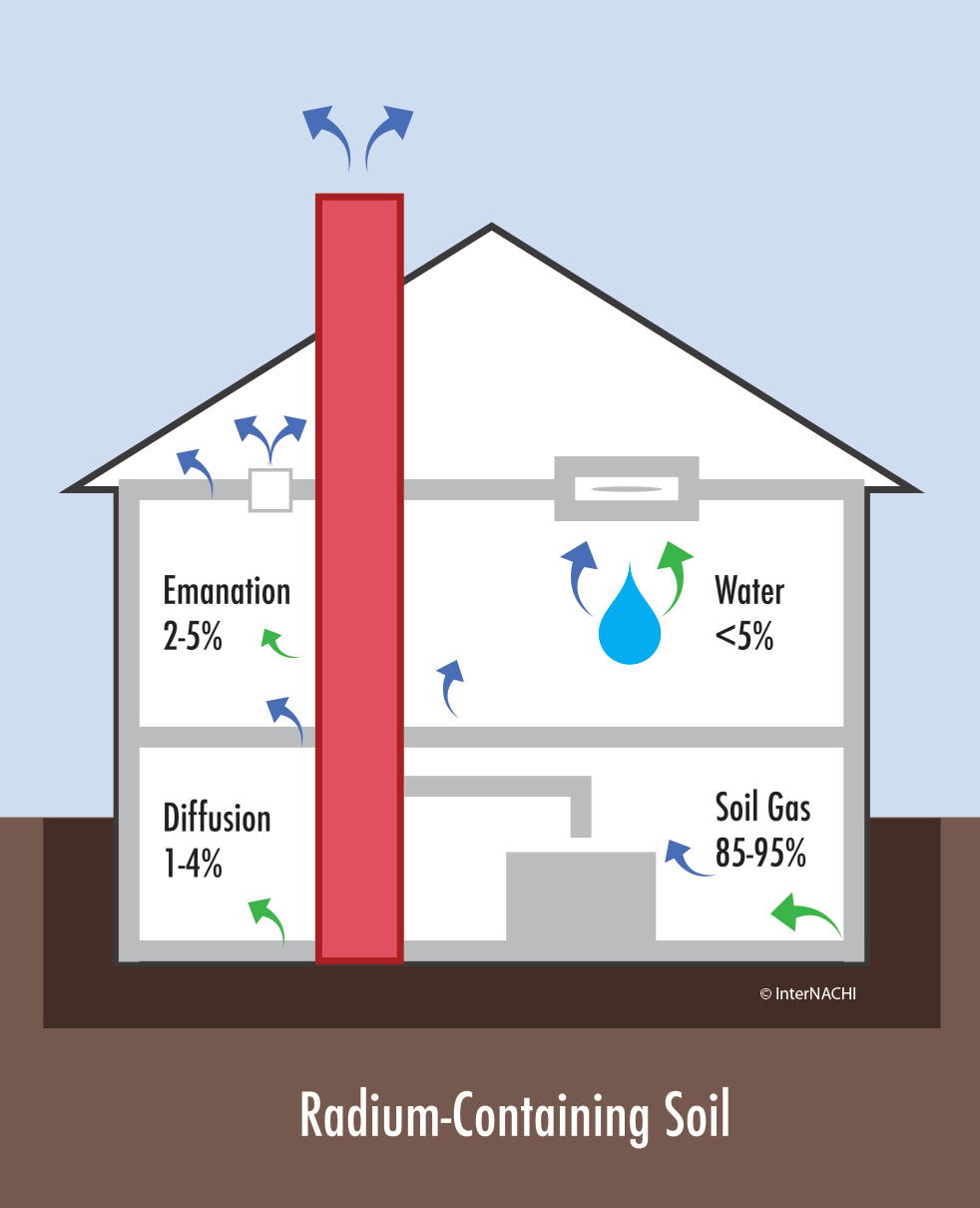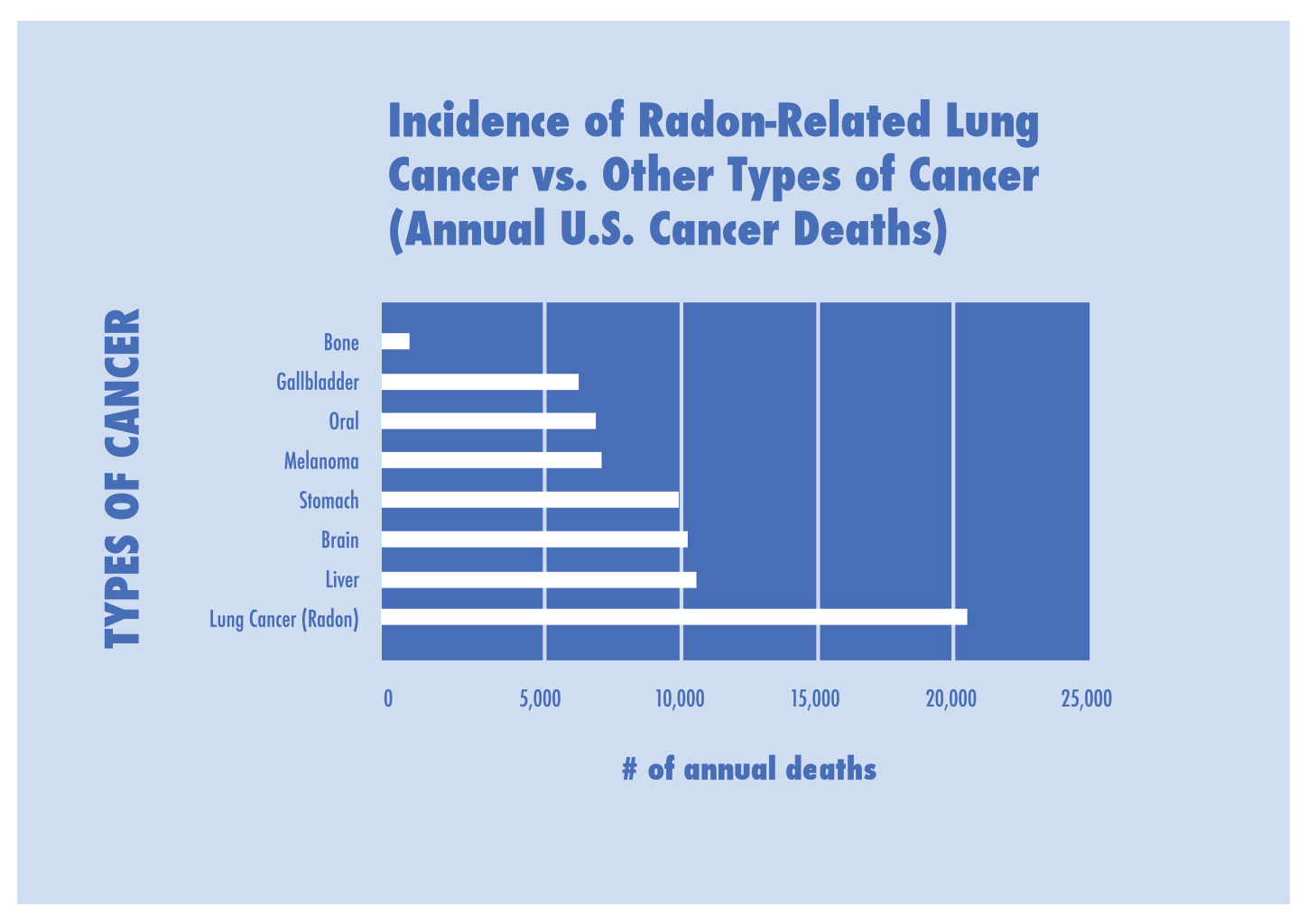Most of the public’s exposure to natural radiation comes from radon, which can be found in homes, schools and office buildings. The illustration shows the sources of radon that can accumulate in buildings.

Radon Sources
Most radon in homes comes from radon in the soil that seeps into homes through cracks in the foundation or slab. The amount of radon in the soil varies widely and depends on the chemical makeup of the soil. There can be large house-to-house differences in soil radon concentrations. The only way to know is to test.
Radon is also found in the water in homes, particularly in homes that have their own private wells rather than those that rely on municipal water supplies. When the water is agitated, as when showering or washing dishes, radon escapes into the air. However, radon from water in the home generally contributes only a small proportion (less than 5%) of the total radon in indoor air in most housing. Municipal water systems hold and treat water, which helps to release radon, so levels are very low by the time the water reaches our homes. But people who have private wells, particularly in areas having high radium soil content, may be exposed to higher levels of radon.
The EPA estimates that the national average indoor radon level in homes is about 1.3 pCi/L of air. They also estimate that about one in 15 homes nationwide has levels at or above the level of 4 pCi/L, the level at which it recommends taking action to reduce concentrations. Levels greater than 2,000 pCi/L of air have been measured in some homes. The only way to know if there is radon in a home is to test for it.
How Does Radon Get into the Body?
People may ingest trace amounts of radon with food and water. However, inhalation is the main route of entry into the body for radon and its decay products. Radon decay products may attach to particulates and aerosols in the air we breathe (for example, through cooking oil vapors). When they are inhaled, some of these particles are retained in the lungs. Radon decay products also cling to tobacco leaves (which are sticky) during the growing season, and enter the lungs when the tobacco is smoked. Smoke in indoor environments is also very effective at picking up radon decay products from the air and making them available for inhalation. It is likely that radon decay products contribute significantly to the risk of lung cancer from cigarette smoke.
How Can Radon Affect Your Health?
Almost all risk from radon comes from breathing air containing radon and its decay products. The health risk from ingesting radon is much smaller than the risk from inhaling radon and its decay products.
When radon is inhaled, the alpha particles from its radioactive decay directly strike sensitive lung tissue, causing damage that can lead to lung cancer. However, since radon is a gas, most of it is exhaled. The radiation dose comes largely from radon’s decay products. These enter the lungs on dust particles that lodge in the airways of the lungs. These radionuclides decay quickly, exposing lung tissue to damage and producing other radionuclides that continue damaging the lung tissue.
There is no safe level of radon; any exposure poses some risk of cancer. The National Academy of Sciences (NAS) studied and described the causes of lung cancer in two 1999 reports. They concluded that radon in indoor air is the second leading cause of lung cancer in the U.S. after cigarette smoking.
The NAS estimated that 15,000 to 22,000 Americans die every year from radon-related lung cancer. When people who smoke are exposed to radon as well, the risk of developing lung cancer is significantly higher than the risk from smoking alone.
The NAS also estimated that radon in drinking water causes an additional 180 cancer deaths per year. However, almost 90% of those deaths were from lung cancer caused by inhaling radon released to the indoor air from water. Only about 10% of the deaths were from cancers of internal organs, mostly the stomach, caused by ingesting radon in water.
Medical Tests to Determine Exposure
Several decay products can be detected in urine, blood, and lung and bone tissue. However, these tests are not generally available through typical medical facilities. Also, they cannot be used to determine accurate exposure levels, since most radon decay products deliver their dose and decay within a few hours.
The best way to assess exposure to radon is by measuring concentrations of radon (or radon decay products) in the air in homes.


